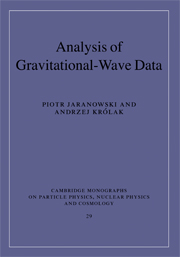Book contents
- Frontmatter
- Contents
- Preface
- Notation and conventions
- 1 Overview of the theory of gravitational radiation
- 2 Astrophysical sources of gravitational waves
- 3 Statistical theory of signal detection
- 4 Time series analysis
- 5 Responses of detectors to gravitational waves
- 6 Maximum-likelihood detection in Gaussian noise
- 7 Data analysis tools
- Appendix A The chirp waveform
- Appendix B Proof of the Neyman–Pearson lemma
- Appendix C Detector's beam-pattern functions
- Appendix D Response of the LISA detector to an almost monochromatic wave
- Appendix E Amplitude parameters of periodic waves
- References
- Index
1 - Overview of the theory of gravitational radiation
Published online by Cambridge University Press: 08 January 2010
- Frontmatter
- Contents
- Preface
- Notation and conventions
- 1 Overview of the theory of gravitational radiation
- 2 Astrophysical sources of gravitational waves
- 3 Statistical theory of signal detection
- 4 Time series analysis
- 5 Responses of detectors to gravitational waves
- 6 Maximum-likelihood detection in Gaussian noise
- 7 Data analysis tools
- Appendix A The chirp waveform
- Appendix B Proof of the Neyman–Pearson lemma
- Appendix C Detector's beam-pattern functions
- Appendix D Response of the LISA detector to an almost monochromatic wave
- Appendix E Amplitude parameters of periodic waves
- References
- Index
Summary
In this chapter we very briefly review the theory of gravitational radiation. A detailed exposition of the theory can be found in many textbooks on general relativity, e.g. in Chapters 35–37 of [34], Chapter 9 of [35], or Chapter 7 of [36]. A detailed exposition of the theory of gravitational waves is contained in the recent monograph [37]. Reference [38] is an introductory review of the theory of gravitational radiation and Ref. [16] is an accessible review of different aspects of gravitational-wave research. Some parts of the present chapter closely follow Sections 9.2 and 9.3 of the review article [16].
The chapter begins (in Section 1.1) with a discussion of general relativity theory in the limit of weak gravitational fields. In this limit spacetime geometry is a small perturbation of the flat geometry of Minkowski spacetime. We restrict our considerations to coordinate systems in which the spacetime metric is the sum of the Minkowski metric and a small perturbation. We linearize Einstein field equations with respect to this perturbation and then we study two classes of coordinate transformations that preserve splitting the metric into the sum of Minkowski metric and its small perturbation: global Poincaré transformations and gauge transformations. Finally we discuss the harmonic gauge, which allows one to write the linearized Einstein field equations in the form of inhomogeneous wave equations for the metric perturbation.
In Sections 1.2–1.4 we introduce gravitational waves as time-dependent vacuum solutions of the linearized Einstein equations. In Section 1.2 we study the simplest such solution, namely a monochromatic plane gravitational wave. In Section 1.3 we introduce the TT coordinate system in which description of gravitational waves is especially simple.
- Type
- Chapter
- Information
- Analysis of Gravitational-Wave Data , pp. 1 - 25Publisher: Cambridge University PressPrint publication year: 2009



